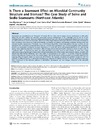Please use this identifier to cite or link to this item:
https://accedacris.ulpgc.es/jspui/handle/10553/8325
| Title: | Is there a seamount effect on microbial community structure and biomass?: the case study of Seine and Sedlo seamounts (Northeast Atlantic) | Authors: | Mendonça, Ana Aristegui, J. Vilas Español, Juan Carlos Montero del Pino, María F. Ojeda Rodríguez, Alicia Espino, Minerva Martins, Ana |
UNESCO Clasification: | 251001 Oceanografía biológica | Keywords: | Seamounts Plankton Oceans Phytoplankton Bionanotechnology, et al |
Issue Date: | 2012 | Project: | OASIS (EVK3-2001-00152) CIMBA 3.3.44 (46-03-03-FDR-00043) ESA/FCT project OPALINA (PDCTE/CTA/49965/2003) DRCT project LAMAR (DRCT-M2.1.2/F/008/2007) |
Journal: | PLoS ONE | Abstract: | Seamounts are considered to be "hotspots" of marine life but, their role in oceans primary productivity is still under discussion. We have studied the microbial community structure and biomass of the epipelagic zone (0-150 m) at two northeast Atlantic seamounts (Seine and Sedlo) and compared those with the surrounding ocean. Results from two cruises to Sedlo and three to Seine are presented. Main results show large temporal and spatial microbial community variability on both seamounts. Both Seine and Sedlo heterotrophic community (abundance and biomass) dominate during winter and summer months, representing 75% (Sedlo, July) to 86% (Seine, November) of the total plankton biomass. In Seine, during springtime the contribution to total plankton biomass is similar (47% autotrophic and 53% heterotrophic). Both seamounts present an autotrophic community structure dominated by small cells (nano and picophytoplankton). It is also during spring that a relatively important contribution (26%) of large cells to total autotrophic biomass is found. In some cases, a "seamount effect" is observed on Seine and Sedlo microbial community structure and biomass. In Seine this is only observed during spring through enhancement of large autotrophic cells at the summit and seamount stations. In Sedlo, and despite the observed low biomasses, some clear peaks of picoplankton at the summit or at stations within the seamount area are also observed during summer. Our results suggest that the dominance of heterotrophs is presumably related to the trapping effect of organic matter by seamounts. Nevertheless, the complex circulation around both seamounts with the presence of different sources of mesoscale variability (e.g. presence of meddies, intrusion of African upwelling water) may have contributed to the different patterns of distribution, abundances and also changes observed in the microbial community. | URI: | https://accedacris.ulpgc.es/handle/10553/8325 | ISSN: | 1932-6203 | DOI: | 10.1371/journal.pone.0029526 | Source: | Plos One [ISSN 1932-6203], v. 7(1), 29526 | Rights: | by-nc-nd |
| Appears in Collections: | Artículos |
SCOPUSTM
Citations
54
checked on Jun 8, 2025
WEB OF SCIENCETM
Citations
51
checked on Jun 8, 2025
Page view(s)
239
checked on Oct 25, 2025
Download(s)
183
checked on Oct 25, 2025
Google ScholarTM
Check
Altmetric
Share
Export metadata
Items in accedaCRIS are protected by copyright, with all rights reserved, unless otherwise indicated.
